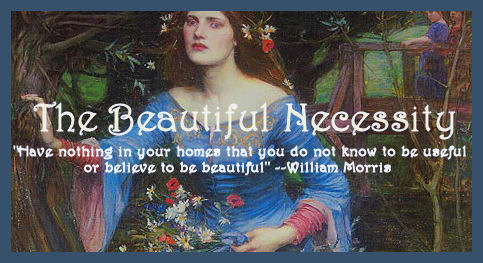 W.B. Yeats has long been my favorite poet. So imagine my joy when I read his biography, Four Years, which discusses his interaction with the Pre-Raphaelite movement. It's a wonderful read!
W.B. Yeats has long been my favorite poet. So imagine my joy when I read his biography, Four Years, which discusses his interaction with the Pre-Raphaelite movement. It's a wonderful read!Elizabeth Bergmann has a wonderful site further discussing Yeats' connection to the Pre-Raphaelites. She says:
To begin with, Yeats's father, John Yeats, was a professional painter; when W.B. was a child, John admired the Pre-Raphaelites, particularly Dante Gabriel Rossetti. He gave William a copy of Rossetti's writings along with a copy of Shelley's, and illustrated one of his son's children's books with Pre-Raphaelite faces. John moved in a circle of Irish Pre-Raphaelite painters, among them Frank Potter, whose Dormouse hung in the Yeats home during William Butler's youth. The painting made such an impression on W.B. that he would remember it years later (1922), when writing his autobiography.
In 1874, John Yeats moved his family to England--specifically, to Bedford Park--in order to take place in a community modeled after Willaim Morris's Arts and Crafts movement. With beautifully decorated homes, simple yet bright clothing, and an active aesthetic discourse, the community would attempt to make reality correspond to the beautiful dreams that the Pre-Raphaelites painted. Before the move, W.B. misinterpreted some things his father said, and was convinced that in this new place: "There is to be a wall round and no newspapers to be allowed in" (Autobiography 27). Upon arriving and finding no wall, he was extremely disappointed. He describes the actual Bedford Park:
"We were to see De Morgan tiles, peacock-blue doors and the pomegranate pattern and the tulip pattern of Morris, and to discover that we had always hated doors painted with imitation grain, the roses of mid-Victoria, and tiles covered with geometrical patterns that seemed to have been shaken out of a muddy kaleidoscope. We went to live in a house like those we had seen in pictures and even met people dressed like people in the story-books. The streets were not straight and dull as at North End, but wound about where there was a big tree or for the mere pleasure of winding, and there were wood palings instead of iron railings" (Autobiography 27).
The four Yeats children took dancing lessons from the sisters of "a well known pre-Raphaelite painter" (Autobiography 28), and the family lived near Burne-Jones. In short, the child William lived surrounded by and steeped in Pre-Raphaelite principles.
Although John eventually rejected Pre-Raphaelitism in favor of a less romanticized naturalism, these childhood experiences had deeply influenced William. Yeats wrote of his youth: "I was in all things Pre-Raphaelite" (Autobiography 76). Although even his early poetry shows less word-painting and more intricate symbolism than that of the Pre-Raphaelites, the statement is not entirely false. John's dismissal of the Pre-Raphaelite movement was the subject of several battles between father and son, and William may have stuck with the movement so closely not only because it appealed to his aesthetic sense, but also because it irritated his often domineering father.
William Morris became the young poet's hero. Yeats took part in the debates of the Socialist League, which occurred weekly at Morris's residence. He "was soon of the little group who had supper with Morris afterwards" (Autobiography 93). Yeats's sister worked as a seamstress under May Morris (sister of William Morris). And by sending the long poem The Wanderings of Usheen to Morris's daughter, Yeats managed to get it under the eyes of Morris himself. As the poet reports: "...soon after sending it I came upon him by chance in Holborn-- 'You write my sort of poetry,' he said and began to praise me and to promise to send his praise to the Commonwealth, the League organ, and he would have said more had he not caught sight of a new ornamental cast-iron lamp-post and got very heated upon the subject" (Autobiography 98). (It's just possible that Yeats cared more for Morris than Morris did for Yeats.)
W.B. gave up the socialist circle in the late 1880s, because all of its members with the exception of Morris rejected religion of any sort.
Yeats actually claims that adherence to or deviance from Pre-Raphaelite principles made and broke his circle of friends in his younger years. His Autobiography contains anecdotes about his prosthelytizing friends who he felt were falling away from the principles of the Pre-Raphaelites. During the 1890s, he belonged to an association of poets called The Rhymers Club (including such figures as Ernest Rhys, John Davidson, Arthur Symons, and occasionally even Oscar Wilde), all of whom admired Pre-Raphaelitism. Teacher and critic Walter Pater, who believed that art need serve no utilitarian, materialistic purpose, encouraged Pre-Raphaelite tendencies in the group.
William Butler Yeats is not a Pre-Raphaelite himself, despite these influences. However, he probably did pick up his extreme love of symbolism from the Brotherhood and their successors. The taste for mysticism that attracted him to the Pre-Raphaelites when he was young later became his full-blown occultism; both he and late Pre-Raphaelite painters, for instance, often portrayed fairies. Yeats's nostalgia for "ancient ways," as he puts it in "To the Rose upon the Rood of Time" is similar to the Pre-Raphaelites preoccupation with the past, although Yeats's ways are often those of mythic Ireland rather than medieval England. He paints very color-conscious poetry, poetry concerned with making the real beautiful without obscuring its reality--the very aim of Pre-Raphaelitism.

No comments:
Post a Comment